Chicago Archives + Artists Project: Media Burn
A conversation with Sara Chapman at Media Burn about their extensive collection of video archives and its historical significance.
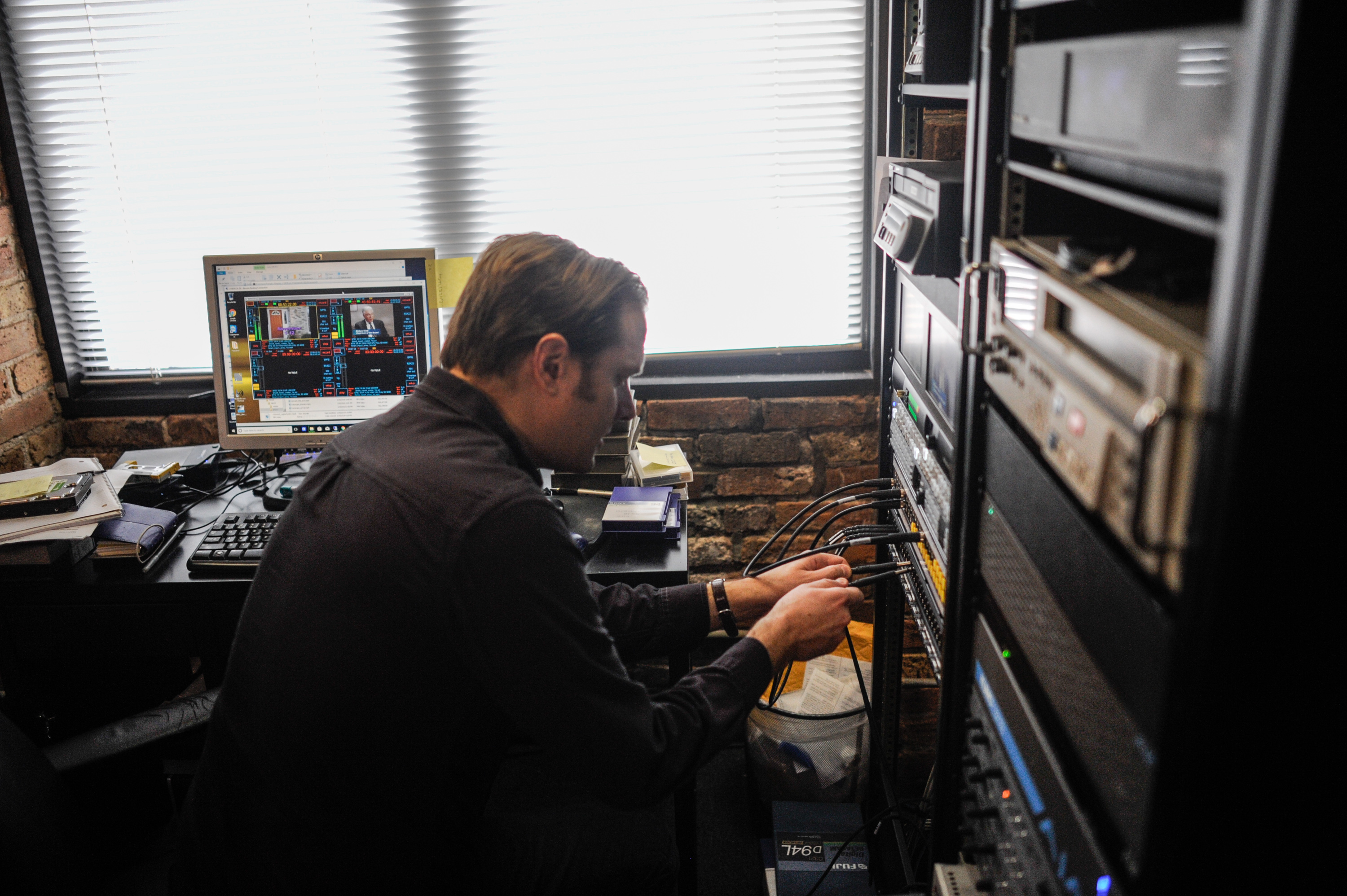
The Chicago Archives + Artists Project (CA+AP) is an initiative that highlights Chicago archives and special collections that give space to voices on the margins of history. Led by Chicago-based writers and artists, the project explores archives across the city via online features, a series of public programs and new commissioned artwork by Chicago artists. For 2018, the Gaylord and Dorothy Donnelley Foundation has funded a series of pilot projects pairing three artists with three archives around the city: Media Burn + Ivan Lozano, the Leather Archives & Museum + Aay Preston-Myint, and the Newberry Library’s Chicago Protest Collection + H. Melt. This series of articles will profile these featured archives and artists over the course of their collaboration, exploring the vital role of the archive in preserving and interpreting the stories of our city as well as the ways in which they can be a resource for creatives in the community. The CA+AP Festival will take place at Read/Write Library on July 13-14.
This interview has been edited for length. Click here to read the full, unabridged interview.
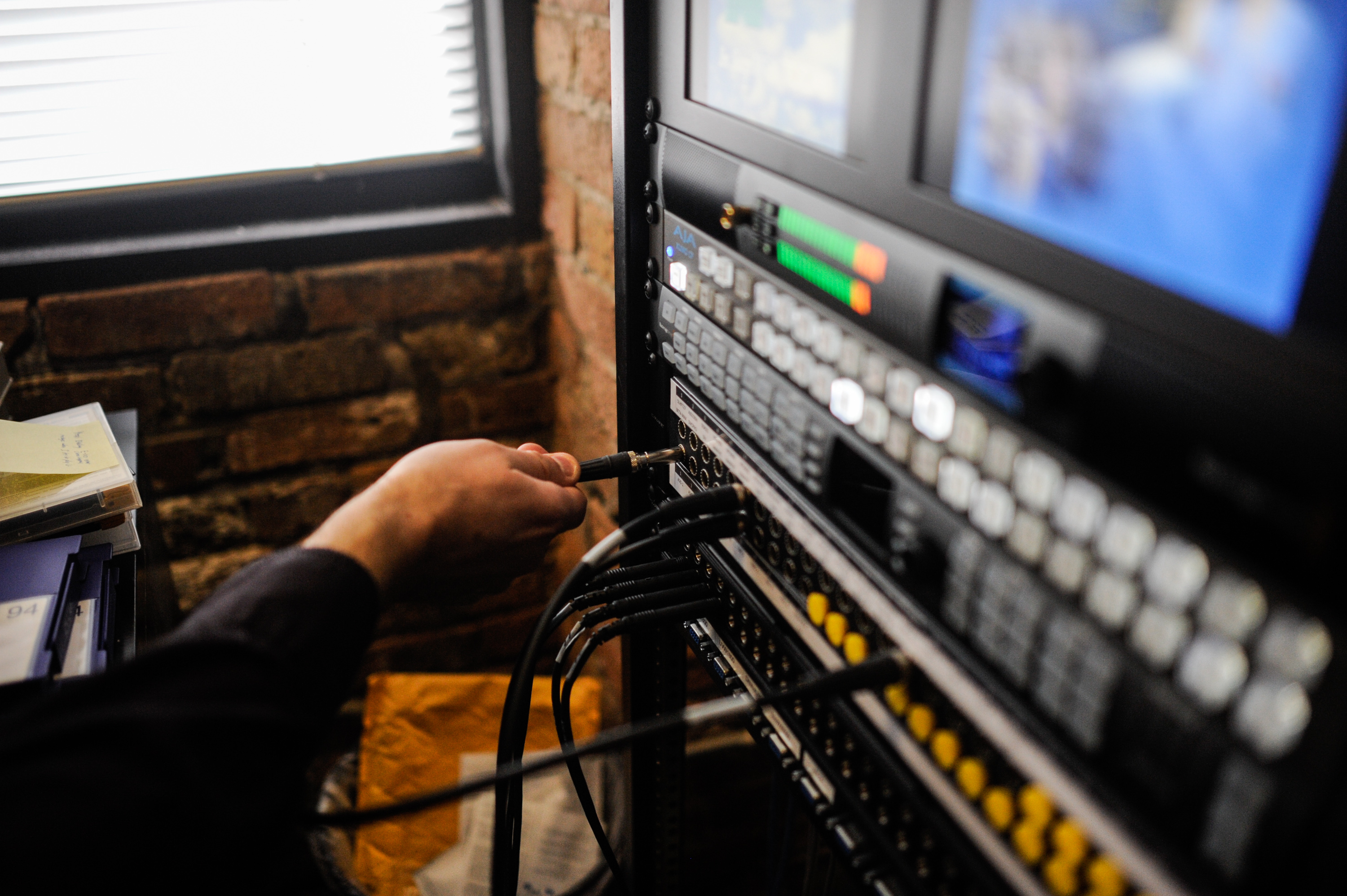
Media Burn Archive, to put it simply, collects, preserves, and restores videos that have been created outside of mainstream media. However, there is nothing simple about saving a recorded history that is quickly deteriorating, making accessible a format whose contents are rapidly vanishing with the passage of time. The archives contents, which include documentary video, experimental video, and guerrilla television, just to name a few, shows history from a different perspective, from literally behind the scenes. Since its inception in 2003, when founder Tom Weinburg and current executive director Sara Chapman joined forces, Media Burn has been able to take a collection of over 8,000 videos and digitize them for viewership online. Their website allows their archive to transcend their modest space and small staff to do something that most archives cannot: give limitless access to their collection from anywhere with a computer and Wi-Fi.
I sat down with executive director Sara Chapman at Media Burn, amidst their wide variety of video formats and equipment, to discuss the archives history as well as contents and how it can be used as an endless source of creativity and historical reference.
Christina Nafziger: How long have you been at Media Burn? How and why did you get involved with the project?
Sara Chapman: Tom Weinberg, the founder, and I sort of came together in 2003 because I was writing my B.A. thesis on video collectives in Chicago, of which Tom was a really important part. So I was doing that and Tom came to speak at one of my classes. My professor Judy Hoffman brought him in. I wanted to talk to Tom and he said that he had, like, 4,000 tapes that he had just been carting from house to house over the years and I was like, “Well, I need to see all of those tapes to write my thesis. You’re the only person who has all these tapes.” He had recently decided to rent a storefront and put the tapes in the there, so I started just going over there over winter break my senior year and just helping to think about organizing them and turning it into an archive. Tom had said, “You know, this stuff is historic, this stuff is one-of-a-kind, and this should be an archive.” But he was a TV producer, a documentarian — not an archivist. It sort of required several people coming together to really make that dream actually happen. Me and then several other people, especially Carolyn Faber, who works at the Art Institute now, helped turn just a pile of tapes into an archive. I think we spent a year just doing the real, basic cataloging, such as making a list of what we had, building a database, putting labels on each tape …
CN: Categorizing …
SC: Yeah. Just the very basic archival tasks probably took at least a year. Then, after I graduated, I just ended up staying here and I have been here ever since. I’ve been here for 14 years now.
CN: That’s awesome. You must have liked it!
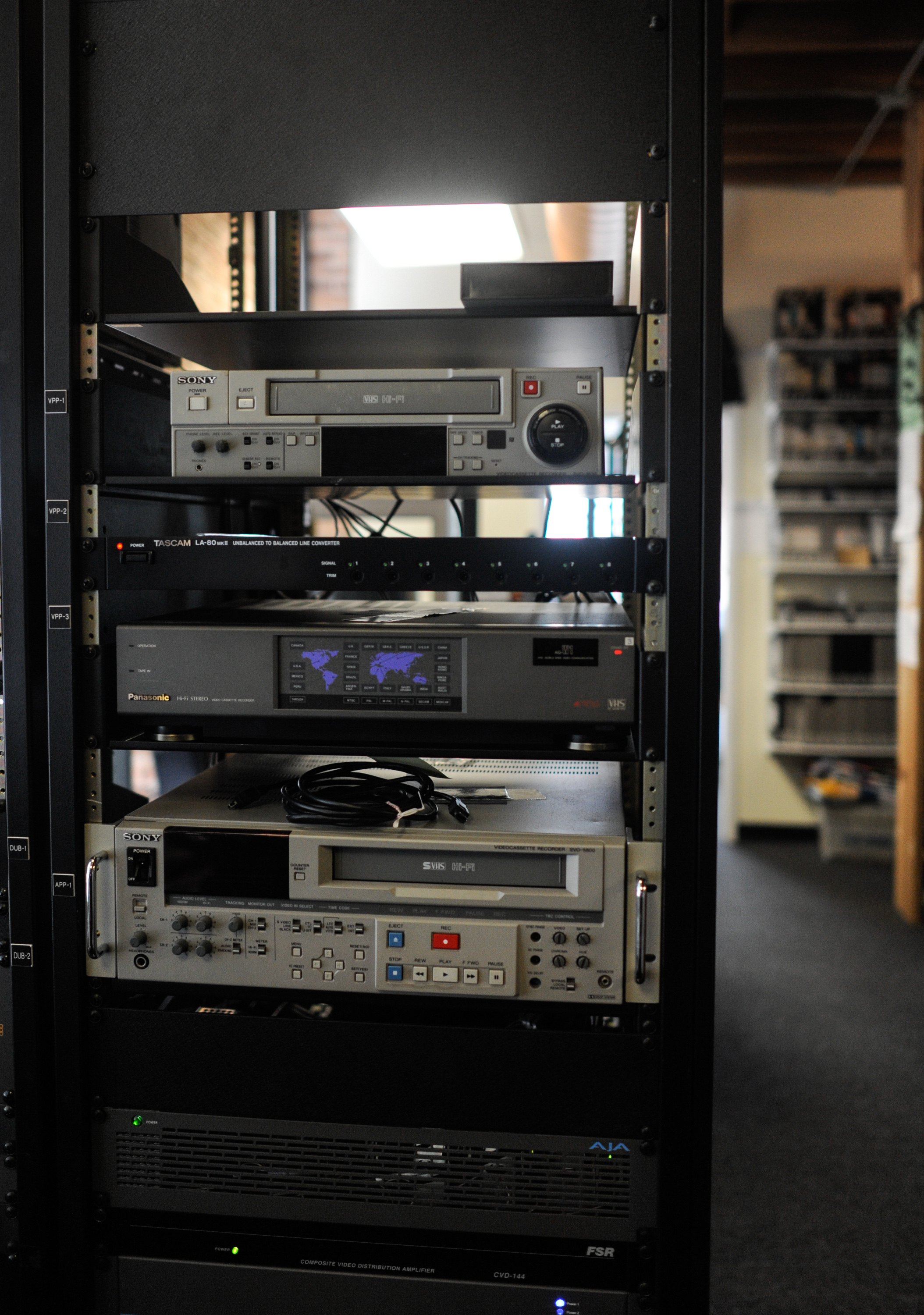
SC: [laughs] Yeah! I did! I am really passionate about the content. We have content that is kind of hard to describe really succinctly, but it comes out of this movement called Guerilla Television, where people — artists, activists, people all around the country — were using this new tool of portable video to try to do things that had never been done before, whether using it for activism, documentary, journalism, or for video art. All of these things were totally new and had never done before, starting around like 1968, 1969. So there is this period where people are experimenting with a totally new medium that no one had ever had access to before. I find this content very exciting. It’s kind of a niche thing. A lot of people have never even really heard of it. But I’m really passionate about it and I’m passionate about saving it and letting other people see it—that’s been the coolest thing.
CN: That is amazing. You can tell you’re passionate about it!
SC: Yeah! The most exciting thing for me about our work over the last 14 years has been that a lot of people who worked in video — especially in the ‘70s — their work was maybe shown in a gallery, was shown in a community center, whatever, to a small group of people, one time. And then they just had the tapes in their basement or in their house or whatever, and no one had ever seen their work and no one had ever heard of them! Being able to sort of take these bodies of work, digitize them, put them online, and sort of bring them into the media canon, for me, has been really exciting. Like this woman Anda Korsts, who did video journalism and experimental video in the ‘70s, she had a really fascinating body of work, but literally no one had heard of her besides the people who worked with her in the ‘70s. She’s been deceased for a long time — and that was one of the first collections we got. We got maybe 150 of her tapes from her daughter, digitized them, and put them online. And she is routinely taught in courses, graduate courses, on film and video, video history. That really excites me — that we personally changed who is important and brought these other people into this canon.
CN: Yeah, it’s kind of incredible because in a way you’re archiving a medium that archives; medium that is recording history. It’s like you said, it is making it readily available, especially as an academic resource — you’re providing so much needed context for all of these artists and performers that, otherwise, it would just be lost! It’s fascinating — I was reading about what Media Burn does online, and it said the medium you work with primarily is videotapes not film?
SC: Correct. No film.
CN: Which is so interesting — when I think of older recording processes and methods, I immediately think of film. And you’re right, what you’re doing is so niche, focusing on such a specific medium like video.
SC: Yeah, yeah. It’s an art form that has always been a bit marginalized, because I feel like film has this, like, high place — like “art is made on film” and movies are made on film. So things made on video often don’t fit into that theatrical running time — they weren’t necessarily shown in a movie theater—and I think they don’t have this cache that film does. On the other hand, film actually can last for a hundred years or more. Film has lasted for a hundred years and, given proper care, it will hopefully last hundreds more. Videotape, on the other hand, only lasts a few decades. If we don’t rush to save it, it’s going to be gone before anybody has the chance to appreciate it — despite the fact that not that many people are very interested in this medium. So that’s really the urgency of what we’re doing. I think what I was going to say before is that, since videotape was a new medium, a lot of different people were drawn to it than had been working in art forms in the past, specifically, women, people of color, community organizers—different people. And I think that we are bringing those outside groups and sort of putting them on the shelf with these other more established artists, which is I think is also really great.
CN: That’s interesting you say that just because, when you were mentioning that before, the first thing I thought of was, around the turn of the century when film or photography was being invented, a lot of the people that brought it into fine art or experimented with it as a fine art form were women because the medium wasn’t yet dominated by men. It just kind of reminds me of that, like videotape as a medium wasn’t dominated by mass culture yet, so that would make sense.
SC: Yeah, and it was very inexpensive and easy to learn. I would say that a pretty astonishing percentage of the people doing video were women, like closer to 50 percent. If you think of, like, filmmaking, up until recently, there have been very few women filmmakers, like at all.
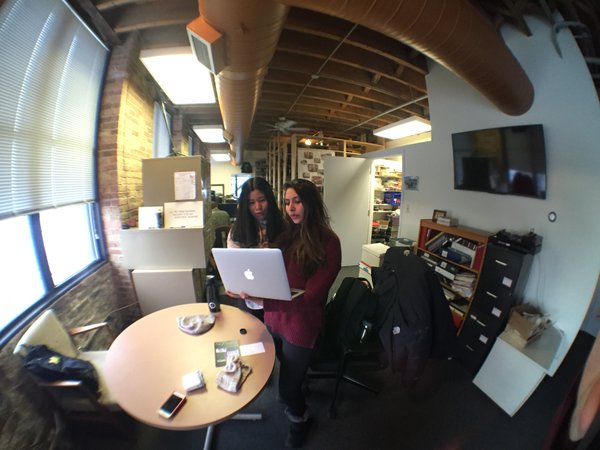
CN: You mentioned how it only lasts so long. Have you lost any videos? Has there ever been a moment when you’ve gone to digitize a tape only to find that the it is too late, that the tape’s contents have deteriorated?
SC: Yeah, totally. I think that pile over in the corner is stuff that doesn’t work. We’re constantly, constantly digitizing. We’ve digitized a lot of our collection, but I do find that things that maybe were digitized, and maybe I played in 2004 or 2005, I’ve tried to play the tape again and, no, it just doesn’t play at all. We’re losing them very, very quickly. And there are often tapes that just cannot be recovered at all. Basically, tape is kind of like…if you think of Scotch tape, and then you just drizzle some magnetic particles on it? Those magnetic particles contain the signal, but they are coming off. So, when they come off, there isn’t anything there. It’s just gone. It’s not like a partial signal. There’s nothing. And you can’t gather the magnetic particles and rearrange them. It’s not like that. With film, there’s a photochemical processes you can do to sort of try to bring it back, or you can clean it, you can remove scratches. With videotape, there’s almost nothing you can do besides transfer it as quickly as possible before the deterioration happens.
CN: So it sounds like it really is a race against time, like every day matters.
SC: Yeah, it is. And in addition to the tapes themselves, we have to keep all the decks working, which is also hard and maybe harder because you’re dealing with machines that haven’t been manufactured in 30 years. You need to basically cannibalize other machines in order to take parts to keep the one working, and there’s a finite amount of U-matic decks in the world. Those haven’t been made in many, many decades.
CN: That actually brings me to one of my questions. What are the different types of videotapes that you work with?
SC: So the first videotapes that existed were portable video, which are these half-inch open reels. So this was like, late ‘60s, early ‘70s. They recorded using this system over there called a PortaPac. It looks very primitive, but it was actually revolutionary because it’s hand-held, it’s pretty small. It comes with this part where the actual recording happens which weighs like 50 pounds. [laughs]
CN: Whoa!
SC: But compared to what had existed, this was very, very, very portable. So when TV first started, TV was just live over the air—not recorded at all. Then, later, it was recorded on two-inch tapes. And the cameras for TV, they’re like the size of a whole guy sitting on it, like the huge studio cameras. So then, when portable video came out, you shifted from not being in the studio anymore to being able to go anywhere you want. It starts with half-inch. Then the next format was U-matic, which was color, and in a cassette now, and much, much higher resolution. This was used a lot through the ‘70s and ‘80s. Then there start being a much wider diversity of formats. There’s BetaCam, there’s a lot of different flavors of BetaCam. There’s BetaCam SP, SX…there’s Digital BetaCam, which came later. They all look, I guess, fairly similar. Then there’s the consumer form, which is BetaMax and VHS.
CN: You mentioned that you have many different types of materials, including experimental video, art video, documentary. Are there any other types? How do you receive the work? Do you accept everything, or anything?
SC: No, definitely not. It has to be produced on videotape. We are just starting to get into stuff that’s produced digitally. Which, you know, everything now is produced digitally. But aside from that limited stuff—and that will be our future—historically, it’s been produced on videotape. So, no film, and usually they are produced independently. By that I mean someone, like, you or I working with a few people, not independent like how Miramax was independent. Independent like, really, just a small group of people doing a project they care about, because they want to—not because there is some sort of corporate entity paying for it to happen. So most of our stuff is non-fiction, in some way or another. It’s the majority. And a lot was produced by Chicagoans — maybe half. It’s a strength, just because this is where we are, but it’s not a requirement. And the content itself is really all over the place. I think we’re open to just anything that is sort of examining the world around us and presenting it for others to learn from it. It’s very broad, but I think we have just reserved the right to decide what we’re interested in and what we like. In the same way that probably you guys probably just decide what art you think is worth promoting and what art you don’t think is worth promoting. So I guess it’s, in some ways, sort of subjective, to Tom’s and my sensibility, but I think our sensibility is very aligned.
CN: It sounds like you’re subjective but you’re also pretty mission-oriented, so you just have the best intention in mind of the organization.
SC: Yeah. We also have news stuff, sometimes, too.
Raw tape from the 1992 Democratic National Convention in New York City. A man holding a camera talks about whether or not we should blame it on the media. This footage was shot by Patrick Creadon as part of The 90’s Election Specials. Video available on the Media Burn website.
CN: Oh, I was watching some of the videos online this morning from Media Burn that seemed sort of like new, and some of it was from the election in 1992? I actually don’t think it was news exactly. It’s interesting because even if the video is showing a type of news, you could see the actual news cameras—it was behind the scenes, so you’re watching both sides, in a way? It’s such a valuable perspective that seems very honest. It’s really interesting, thinking about the camera and the studio becoming handheld, and just thinking about the large contrast of authorship that must have happened due to that transition, that changed who is doing the actual filming. If only a few people have access to this equipment, then you’re seeing just one perspective from this one group of people. But then all of a sudden this equipment is handheld and becomes more accessible, and then the authorship of the video becomes completely different, changing what you’re seeing.
SC: Yeah, yeah, exactly. I mean that’s what was so exciting about that time period and about the invention of video.
CN: I was reading online just a little bit about Media Burns’ history, and you had mentioned the founder …
SC: Tom Weinberg.
CN: Yeah, and how he had this collection. So, when you started being involved, it wasn’t an archive yet? It was just his collection?
SC: Yeah, he had wanted it to be an archive. That was the goal. But it was mainly just his collection. So Tom produced a lot of documentaries, a lot of TV shows, especially for PBS. He created this show called “Image Union,” which is on Channel 11, which was a showcase for independent film and video in Chicago. People would just submit their work, and it would get on the show or not, and they’d get paid a little bit, and it would be on TV. He produced that from 1978 to 1988. Then, after that, he left to do the show on a national level, and it was called “The ‘90s,” and was on for three years.
CN: That’s so cool!
SC: Yeah, yeah. And so “The ‘90s” was on national PBS all around the country. There’s 52 hour-long shows that we have of that. So, a lot of Tom’s work has not been, “I want to make this thing and here it is,” it’s been bringing together hundreds of independent producers to collaborate on a project, even going back to starting in the ‘70s with these video collectives that were really collaborative projects. Tom’s collection was the work of hundreds and hundreds of different people that he worked with over the years to make various shows. So it’s related to his work, but it’s not all authored by him. It’s not a collection in the way someone might collect, you know, anything. It’s not like, collective. But there’s a connection there.
CN: Yeah, like a collaborative *slash* curated collection?
SC: Yeah, totally. The collection has expanded since then because people continue to donate their collections. Some of our recent collections this year have been from Carol Marin. She’s a journalist who’s been working for several decades with various stations— I think NBC and WTTW. She’s just one of the best journalists in the country, of TV journalists, so we’re really excited about her collection. We’re processing it. This year we also just got materials related to the documentary “Howard Zinn: You Can’t Be Neutral on a Moving Train,” which was a feature documentary about Howard Zinn. And so — I’ll step a little bit backwards — a lot of what is important to us to collect is camera-original footage. Like, all of the footage. When you shoot an hour-long program, you might shoot 50 hours of footage or whatever. Maybe you didn’t need all of the footage for the purpose of your show, but it might have footage that’s very, very valuable to us, especially as time has passed and it becomes really a historical record.
CN: I’ve never thought of that, like what they edit out is actually a really good insight to what is actually happening behind-the-scenes.
SC: I mean, especially for documentaries, because the footage is just more of what’s going on. It’s not like people are standing around, you know, just smoking a cigarette. I mean, life is continuing to happen even though they didn’t choose to put it in the final cut. So, yeah, it can be valuable if you want to look at a program and find the bias of the filmmakers, what better than to watch the whole interview unfold in real time and find out what questions they ask? Why did this person say that thing? Were they prompted? Did it come out of nowhere? Sometimes you shoot a person or shoot an event and it just didn’t relate to the story. You know, we’ve got tons of footage of Rahm Emanuel fundraising for Bill Clinton, and Rahm Emanuel was pretty young then and he wasn’t really a [known] guy but that’s important to have now. Also, you discover people in the footage. During the last election, Kartemquin Films, a local documentary organization, found footage of Bernie Sanders getting arrested in 1963 in a Civil Rights protest.
CN: Wow!
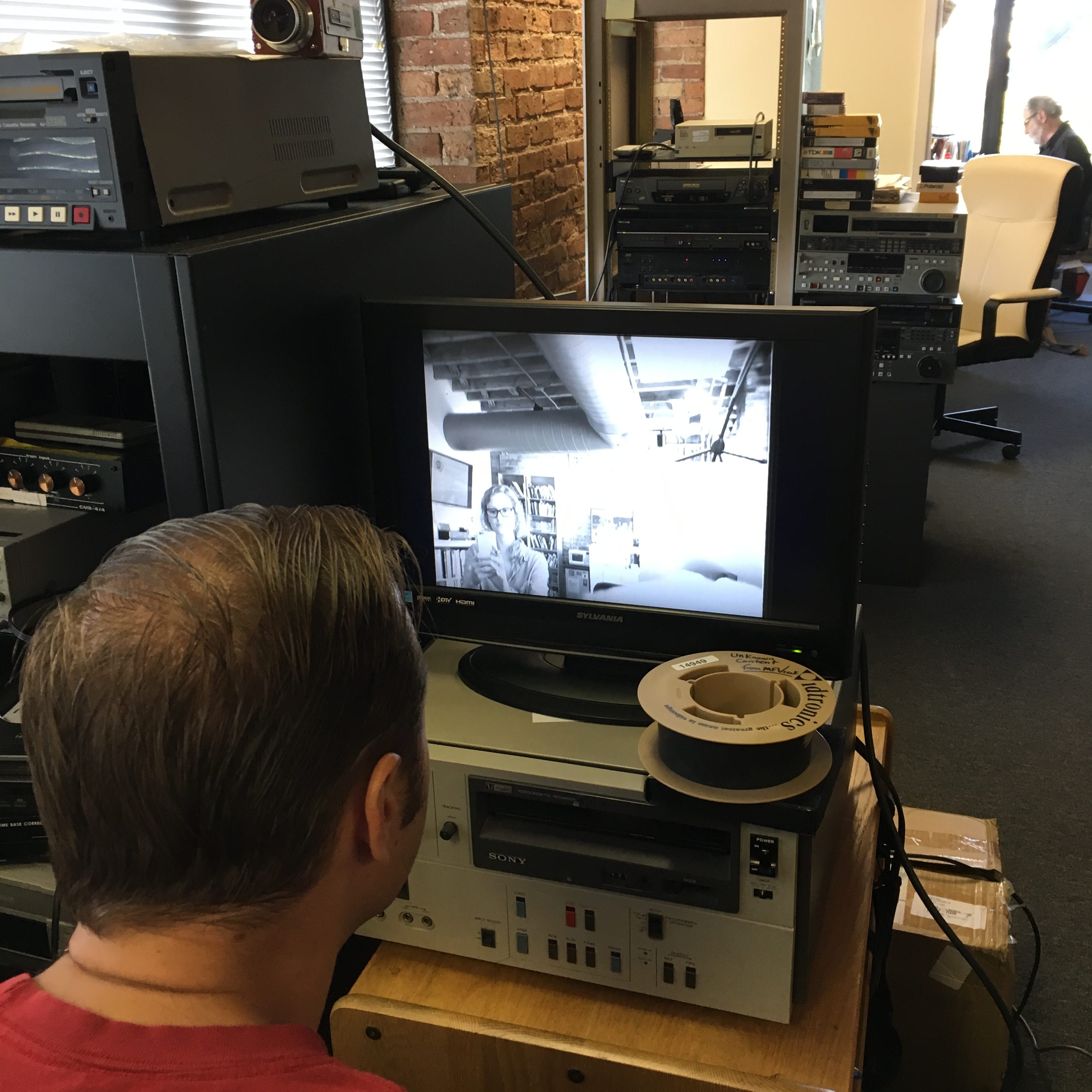
SC: And Bernie Sanders was, you know, just a guy! If they hadn’t saved all those outtakes, they wouldn’t have had that. And other things—if you want to step back in time and experience an event, meet a person you didn’t know. I mean, when you have hours and hours of footage instead of just the brief clip you would use in something, you can see the décor of a place or how people dressed or how people interacted with each other.
CN: And mannerisms, and little details …
SC: Yeah! It’s just like stepping back in time. Again, this is something that hasn’t always been recognized by everyone — by funders, by supporters — but we just think that saving that camera-original footage is the most important thing we can do to document the 20th Century.
CN: You’re completely right. It’s so valuable! It’s like reading someone’s diary! It’s so intimate.
SC: But it’s even less filtered, almost. You can choose to point the camera this way or that way but what happens happens.
CN: Exactly. And what’s said is said.
SC: It’s not your recollection of it.
CN: Yeah, it’s in real time, what’s really going on. There’s no stepping backwards. That’s invaluable … and amazing!
SC: Yeah! Yeah, I’m glad you feel that way. Because a lot of time people say, “I don’t know why you want to save the outtakes.” You know, like, “that stuff wasn’t good enough to be in the movie.” And it’s like, well, for historical purposes the footage has other lives and other uses unrelated to what this particular filmmaker wanted to do with what they were shooting.
CN: Yeah! Even just interactions. I’m just thinking about, one of the videos I watched this morning on Media Burn’s website, which was somebody documenting the filming of a commercial, and just the interactions between people on set. And if you just think about, historically, it was all men. I was thinking, if this was a commercial where the actress was a woman, what would the interactions be? That’s just interesting culturally, what does doesn’t change over time in a certain industry. And if they had just turned the camera off, we wouldn’t have that. Or if you just delete that footage, then we wouldn’t have that.
SC: Right, and I think that you don’t know what is going to seem interesting in 20 years or 30 years. So to make that decision right now — like, “this stuff is not interesting” — is a mistake. Because you just don’t know. Everything seems normal to us right now — we’re not going to know what, in 30 years, will have changed culturally that is going to strike you as being so of this era. Stuff like that.
CN: Yeah. There’s so many things we can’t see except in hindsight. Of course we’re going to think it’s “normal” if we’re living in it.
SC: Yeah. So, I think that a lot of the focus of the people in our collection has been that stuff—showing the mechanisms of media, of the creation of commercials, of the creation of news. That’s something that comes up, again, throughout our collection—trying to show the full picture. You know, when someone’s doing a little thing for the press, all the camera people are there trying to make it seem like there are no other cameras there and that they’re just there. But our people usually try to show the whole thing, to show that this is what is happening. It’s not just Clinton talking to you, it’s Clinton talking to 20 cameramen, and that’s important.
CN: Yeah, that was actually one of the videos I was watching—it was just so interesting. I mean, the media, media in general, shapes so many things. My brother was working for a long time as a news reporter. We talked about this all the time, about how you’re shaping how people see things, literally how people view other people, issues, events. Not only that, but also, historically, what’s remembered now, which is what’s recorded now, because they delete the rest. So to have different voices showing different sides of the same picture is so important historically.
SC: And to show you how the picture is constructed. I think that understanding that is important.
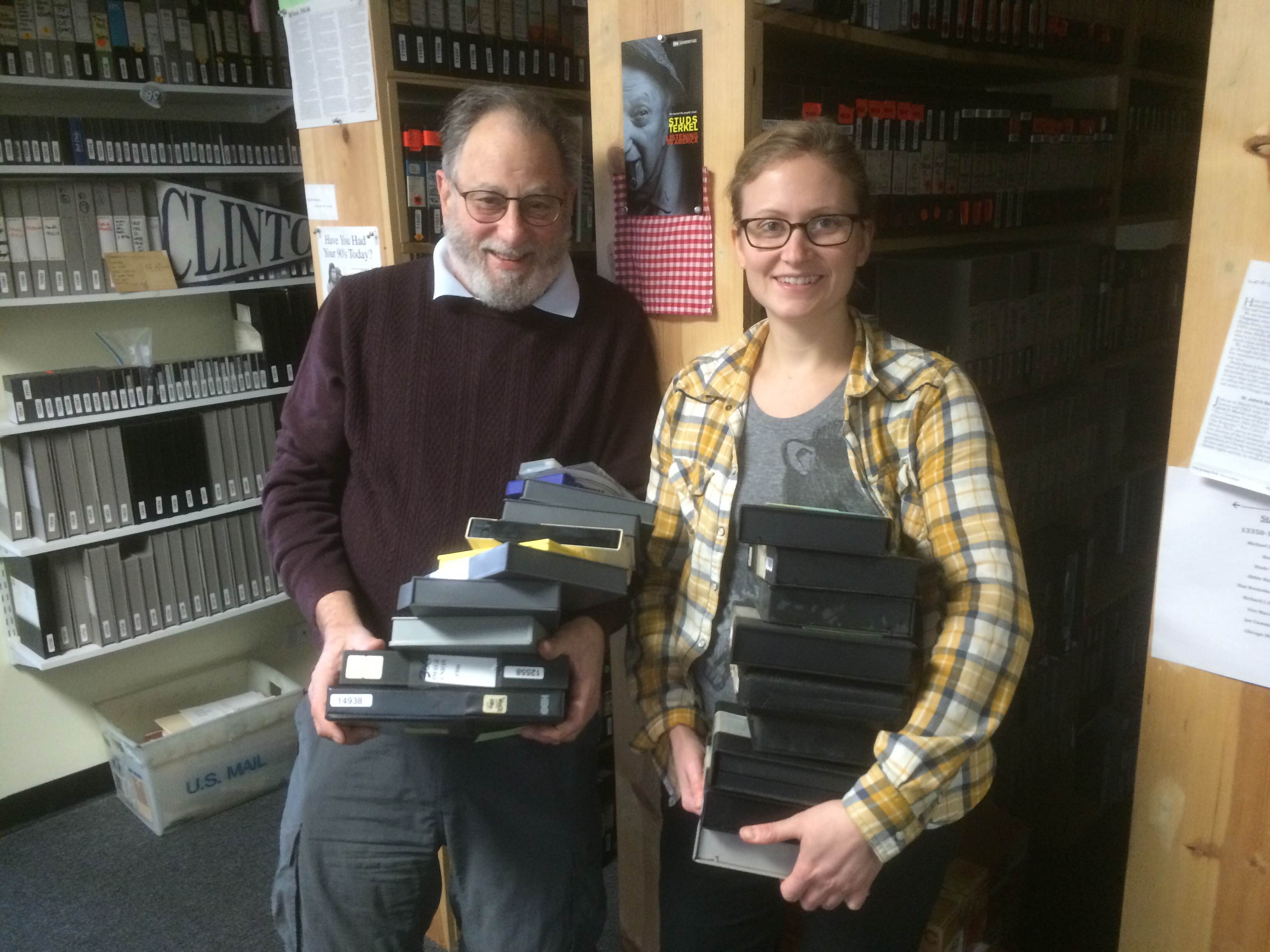
CN: Yeah, for sure. This is kind of going back to the archiving project that you are working with Sixty on. In what ways are the public or artists and creatives in the community able to access the contents in the archive, whether that’s online or in person?
SC: Well, just given the nature of videotape and the fact that we need to digitize it, in general, if someone wants to see something that isn’t yet digitized, we just digitize it, because it doesn’t make sense to have them come in and be playing these tapes that may or may not work. We don’t want them to break the equipment. It’s easier for us to just digitize it, put it online, and then from then on anyone who wants to access it can. So generally, everyone accesses digital files online.
CN: Yeah, I’m sure that for them it’s easier, too, because they can pause it and revisit it–
SC: Yeah. The only downside I think for us is that we don’t always know what things are happening. Like, sometimes I’ll meet an artist and they’ll be like, “Oh, I’ve used your stuff for my projects,” and I’m like, “Oh. Okay. Well, I didn’t know.” I think it’s useful for us to know that that stuff is happening to sort of be able to demonstrate the impact of our work. So, the fact that it’s so accessible often obscures [data]—like, you know, we have Google Analytics so we can see that x number of people are watching the videos, but we don’t why they’re watching the videos. We don’t know if they’re just doing this for entertainment, or if they’re using it in a class. We don’t know if they’re using it for an art project.
CN: You can see that people are watching them and using this archive, but you don’t exactly—because it’s not face to face collaboration—you don’t know in what capacity they’re using the material?
SC: Yeah. And I think that’s important. That’s always one of the first questions people ask. “Who’s using it? Why are people using your stuff?” You know, you have case-by-case examples—mainly local ones, because you run into someone and they tell you that they used it. But they don’t have to tell us! So in general we don’t know all of these cool things. It would be great to have all of the examples at hand of what people are doing with them.
CN: Yeah, I’m sure it’s countless.
SC: Yeah. Right. I mean, Tom, the founder, ran into Dick Simpson, who’s a professor at UIC and an author and activist, and he told Tom that he’s been using one of Tom’s documentaries, “Vito,” in his classes for 25 years. And Tom never knew that. That type of thing is really cool and an honor, but it’s also frustrating that we can’t get that information easily.
CN: Yeah, and also what you just mentioned — especially when writing grants or approaching foundations — having that information and stories of how it’s being used. Because educationally and creatively I’m sure it’s just a never-ending resource. There’s so much material online — I was looking through it today. Is it searchable by the name of the person creating it? Is that how it’s navigated?
SC: [It can be search by] sort of any words you want. So we log them on a shot by shot basis — sort of describing everything — with the idea that someone might want to find a shot of, you know, the Sears Tower in the ‘70s, or someone might be interested in the fact that, at that location, Studs Terkel is talking about the neighborhood of Uptown. So it’s all sorts of things —it’s the images that appear on-screen, it’s what people are talking about; it’s the larger concepts like feminism or something like that. You just search online [on our site]. You can find a whole variety of things, which is really exciting. And our videos have gotten more than 18 million views online, which is [a lot] compared to other archives where there’s the archive and there’s the reading room and researchers come in. I can’t imagine that at most traditional, small archives that it’s more than a dozen researchers per year or something that are coming in. But I feel like we’re almost at a disadvantage because we don’t have that list of like, “So-and-so came in and then they published this book and here it is” and, “So-and-so did this with it.” We’re just like, “Here they are, 2 million views,” or whatever.
CN: That’s really great, but yeah, there are the pros and cons–
SC: Right, right. So it’s a little bit of a paradox that the more accessible we make things the less cache they are just because they’re not a secret.
CN: Yeah, yeah. There are pros and cons, definitely. I had another question, kind of going back to the archiving project a little bit. How do you envision the archive acting as a tool and a resource for creatives in Chicago or elsewhere, and what do you think can or what do you think is learned from interacting with the materials?
SC: Well, I think that one of the exciting things, for me, is that our content is so diverse and there are just so many ways of using it that I can’t even imagine, and that we just kind of have to be— friend of mine called us—“agnostic” archivists. You know, that we just save everything.
CN: I love that.
From inside the Bally/Midway factory we watch as employees assemble the Ms. Pac-Man arcade game. The video features several long shots of the entire factory and detailed close-ups of individual processes, like soldering and wire stripping. Full, raw video available on the Media Burn website.
SC: It’s interesting because a lot of times the footage that we save that people end up responding to is stuff that, like, Tom and I don’t think is important. Like, Tom had all these boxes—he was making a pilot for a show about technology in 1981 or 1982 called “Wired In,” but they didn’t end up making the show—so he just had all of these boxes of tapes that they shot for the pilot—just footage of various technology stuff, like kids using early computers, Apple headquarters, the inside of the Ms. Pacman factory. And it’s b-roll—it’s not put together at all. It’s just literally, like, walking around that factory, for example—you see the machines. Nothing’s happening other than just showing you what it looks like. And we literally almost threw that away. I remember the day that we were like, “Should we throw this away? Let’s throw it away. Eh, I guess we can keep it. I don’t know.” And that footage has been insanely popular.
CN: Really?
SC: That’s been some of the most popular footage of ours, the footage of the inside of the Ms. Pacman factory. And again, it’s not edited, it’s like 20 minutes of just, you know, long shot of the room, close-up of the room—just what it looks like, just what it was. And we thought it was totally unimportant, but to many hundreds of thousands of people, it’s very important and it’s what they want.
CN: That’s so interesting.
SC: So I feel like when other people use our stuff, it’s always unexpected to me, but it’s always really cool. It’s never what I would do. Like we did this project with Yollocalli Arts Reach, which is an arts program for youth in Little Village, on the South Side. So we wrote the grant—we got a grant from HIVE, this funding organization—and our conception was like, “Okay, so we have all of these disadvantaged minority teens and they’re going to use our videos and to think about problems in their neighborhood and they’re going to want to talk about, you know, gang violence or poverty or immigration or these heavy things. They’re going to want to use our footage to, like, help them talk about those things.” So we wrote the grant and we got the funding. And the Yollocalli teens’ teacher, fortunately, just basically didn’t really come up with a very strict curriculum, he just said, like, “You guys are going to use Media Burn. Do it.”
CN: That’s awesome. How old were they?
SC: High school age, and then a few months later I got to come in and see the projects and all of them had created video art. Just, like, experimental, abstract imagery—just crazy, surreal, weird stuff. Like, literally none of them were interested in what we thought these kids would be interested in. We thought, “Oh, they’re going to want to know about, ‘oh, my Mexican grandma,’ or ‘I want to hear about Mexico’.” They were not even remotely interested in any of those things. And that was really exciting, you know, to just have them do something totally different than what we wanted. And great! That’s just really great to me. Similarly, our project with Chicago Archives + Artist Project, last year, we were paired with On the Reel Film, which is two filmmakers, Erin Babbin and Michael Sullivan. So, again, we sort of collaborated together to think about ways that we could combine their footage with our footage, and they were going to make a piece. So the way we started was, they thought about subjects in their collection—you know, their own archive of their own work as well as their own home movies and they said, “Bulls” or “San Francisco” or whatever. And so I would respond to the topic with some of our footage that might relate. So then, at the end, they edited all the footage together. So this footage was our footage, which is archival video; old home movies of her mother and grandmother—so like Super 8 footage, stuff like that—as well as, then, that production company’s footage of stuff they had shot for documentaries—so professional, home movies, and our archival stuff. So they made this multi-channel piece that we showed at the Cultural Center, and I kind of thought that you were going to look at it and you were going to see, like, three things. You’d see film, video, and digital. Or you’d see professional footage, amateur footage, and archive. But instead, the piece, as it turned out, unified it. Like, you didn’t feel the difference. Everything actually felt so much more similar. Erin found that—in the footage her grandmother had shot, that she had shot, and that we had of the Golden Gate Bridge—everyone shot the same shot! You know, decades and decades apart, everyone shot the same shot. So I didn’t get to see the piece in advance, and we were going to discuss it afterward, so we prepared a little bit after for what the discussion was going to be. It actually just surprised me so much that it wasn’t what I thought was going to be— I thought it was really going to be about these differences in media and like media history. I thought it was kind of going to be, like, “Well, this showed me this thing about this era and this thing about this era and we look at different eras differently because of the media that we had to record them,” and I found that none of those talking points even applied because it really unified everything. So anyway, that’s just a long-winded way of saying that it’s great to me that, in general, I’m always surprised by the way people use [the videos] and that’s the best part of it.
The Chicago Archives + Artists Project (CA+AP) is part of Art Design Chicago, an initiative of the Terra Foundation for American Art exploring Chicago’s art and design legacy, with presenting partner The Richard H. Driehaus Foundation. The project is funded by the Terra Foundation for American Art and The Richard H. Driehaus Foundation.


Christina Nafziger is a freelance arts writer with a background working in curation, arts administration, and community outreach. Earning her M.A. in Contemporary Art Theory from Goldsmiths University of London, her area of research focuses on performativity within the image, virtual identity, and cyborg theory.